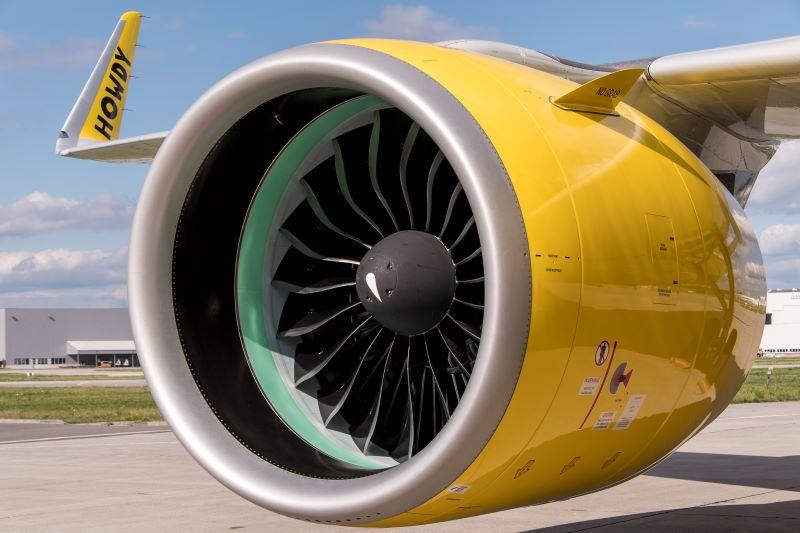
Spirit Airlines’ unit costs and profitability are continuing to be negatively affected by significant reliability problems posed by Pratt & Whitney Geared Turbofans (GTF) across the ULCC’s nearly 70-strong Airbus A320neo fleet.
“Over the last six months, the GTF NEO engine has experienced diminished service availability, an issue that has been steadily increasing over this period,” Spirit CEO Ted Christie said during a Feb. 7 earnings call. “Pratt & Whitney continues to struggle to support its worldwide fleet of neo aircraft as MRO capacity remains constrained and turnaround times for engines in the shop have been nearly three times longer than the historical averages for ceo engines,” he added.
Spirit revealed “30 plus” engines have been removed from the wing over the last six years from the fleet, well exceeding the average of six-to-eight years before removal, noting the vast majority of neos have been delivered just over the previous two years.
“This is not a Spirit only issue,” Cowan senior analyst Helane Becker said in a note following the earnings call. “Other airlines (e.g., Hawaiian Airlines) cited concerns about the A320neo engine issues as aircraft are taking longer to come out of maintenance. This drives maintenance costs up and requires aircraft to be parked. This is less problematic in late January/early February than it will be if these issues linger through the summer.”
Christie praised Pratt’s performance and fuel efficiency. Still, he panned its reliability, revealing that within a two-week period, the carrier went from having two A320neo aircraft parked without operable engines to having seven A320neo aircraft sidelined due to these issues. Compounding this is the lack of engines and spare parts.
Asked to comment, a Pratt spokesperson told Aviation Daily that the company is addressing supply chain part shortages which are impacting MRO output and spare engine availability. “Pratt & Whitney is coordinating closely with our customers on solutions to minimize operational disruption,” the spokesperson said. “We are also working mitigation strategies with our suppliers, expanding shop capacity, and continuing upgrades to extend engine time on wing.”
Airbus delivery delays of 13 A320neos and 23 A321neos set for Spirit only add to the airline’s pain. Airbus notified the company that seven expected 2023 deliveries will be delayed until 2024, which may cascade some aircraft into 2025. Spirit’s previously announced accelerated retirement of 29 A319ceos from its fleet in 2023-24 and the final two in 2025 add to capacity constraints and unit cost pressures.
Spirit rates these factors at 40%, 30%, and 20%, respectively, as the major culprits denting its fleet utilization by 10%, at least through the year’s first half. “That should improve to around 5% in [the third quarter] and back to what we consider normal utilization levels in [the fourth quarter (Q4)],” CFO Scott Harrison said. This base case centers around GTF reliability relief, but “if we’re wrong, then there will be potential utilization penalty in the fourth quarter,” Christie added.
The remaining 10% reduction is related to “continued buffers we have in place to support the operation due to continued industry infrastructure constraints,” Christie said. These disproportionately impact flights to and from Spirit’s Florida home base because of air traffic control and weather woes. Labor challenges are also weighing down the utilization and optimization of its network, though the company is seeing these headwinds abate.
As a result, the company is being more conservative in its capacity growth in the first half of the year, anticipating an increase of 19 to 23% for full-year 2023 compared to 2022. “This is about a 450 to 550 basis point reduction versus our previous plan,” Harrison said.
Spirit recorded a total Q4 2022 operating revenue of $1.4 billion—an increase of 40% year-over-year that was even “better than expected,” the company said. Fiscal 2022 revenue was a robust $5.06 billion—shooting up 57% over 2021. However, red ink splattered across the balance sheet with a $270 million net loss in Q4 widening over the year’s previous losing quarters.
Late-season hurricane activity and winter storm Elliott had an outsized effect on operations resulting in the cancellation of 1.5% of Q4 capacity. “It was messy,” Christie said. The airline accomplished a solid on-time performance of 73.2% and a flight completion factor of 97.0%, according to U.S. Transportation Department statistics.
Full-year profitability continued to evade the ULCC, with 2022 revealing a net operating loss hemorrhage of $554 million, widening from $472 million the previous year.
The recently ratified pilot contract impacts Spirit’s cost per available seat mile, excluding fuel, by an estimated 4.5% for fiscal 2023. Labor quoted at 60% of the carrier’s operating expense ex-fuel, plus airport costs and high fuel prices, are additional drags on profitability, causing Spirit to estimate a -2 to -4% operating margin in the first quarter. Spirit does expect to return to profitability for the full year 2023.
The company only offered a limited update on the ongoing U.S. Justice Department (DOJ) case against its takeover by JetBlue Airways. “We are now waiting to see whether the DOJ files suit to block the deal or allow us to proceed,” Christie said. “We anticipate hearing from the DOJ in the next 30 days or so.”
